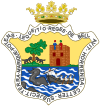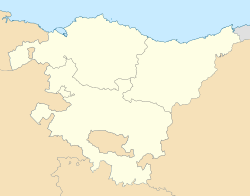Lekeitio facts for kids
Quick facts for kids
Lekeitio
Lekeitio
Lequeitio
|
|||
|---|---|---|---|
 |
|||
|
|||
| Country | Spain | ||
| Autonomous community | Basque Country | ||
| Province | Biscay | ||
| Comarca | Lea-Artibai | ||
| Area | |||
| • Total | 1.90 km2 (0.73 sq mi) | ||
| Elevation | 0 m (0 ft) | ||
| Population
(2018)
|
|||
| • Total | 7,258 | ||
| • Density | 3,820/km2 (9,894/sq mi) | ||
| Demonym(s) | Lekeitiarrak (Spanish: Lequeitianos) | ||
| Time zone | UTC+1 (CET) | ||
| Postal code |
48280
|
||
Lekeitio (pronounced le-kay-tee-oh in Basque, or Lequeitio in Spanish) is a lovely town and municipality in the Basque Country, Spain. It's located in the province of Biscay, about 53 kilometers northeast of Bilbao.
Around 7,300 people live in Lekeitio (as of 2019). It's known as one of the most important fishing ports along the Basque coast. During the summer, Lekeitio becomes a popular spot for tourists. People enjoy its beautiful Isuntza beach and the nearby Karraspio beach in the town of Mendexa.
The most famous building in Lekeitio is the Santa María church. It's a stunning Gothic basilica that was built in the 15th century. Lekeitio is also the hometown of Resurrección María de Azkue, a very important Basque scholar from the 1800s.
Contents
Festivals and Celebrations
Lekeitio is famous for its lively festivals, which bring the town to life with fun and traditions.
San Pedroak
The celebration for San Pedro takes place from June 29th to July 1st. It starts with a special mass (church service) to honor the saint. After the mass, there's a procession where people carry an image of Saint Peter through the town's streets.
San Antolinak
These festivities honor the town's patron saint, San Antolin. They are celebrated from September 1st to September 8th. One of the most exciting and well-known parts of this festival is the goose pulling event.
The Goose Pulling Event
The goose pulling event happens on September 5th. The goal is to hold onto a goose for as long as possible. The goose hangs from a rope that stretches across the harbor. One end of the rope is fixed, and a group of men on the other side pull it up and down. The goose is covered in oil to make it slippery. In the past, live geese were used, but today, the geese are not alive.
Many boats take part in this event. Each boat takes its turn, decided by a lottery in the morning. One person from each boat must grab the goose by its neck as tightly as they can. As the boat moves forward, the men on the dock pull the rope, lifting the participant and the goose high into the air. Then they let them drop quickly, only to pull them up again. This continues until the participant lets go of the goose or the goose's neck breaks. The person who manages the most "ups and downs" wins the competition.
This event has been recorded since the 5th century, and its origins are believed to be even older. The modern version of this act has been celebrated since 1877.
In the past, the goose pulling event was also held on dry land. Today, it is still done this way in Markina-Xemein. The festival has changed over time. For example, in the past, all boats had to be sailed by 13 sailors. Only sailors were allowed to participate, and there were strict rules about the boat's speed and size. If there was any doubt about who won, they would have a boat race to the island near Lekeitio.
During this festival, people often wear traditional denim work clothes with a white shirt.
Ancient Cave Art
In 2016, an amazing discovery was made in the Armintxe Cave near Lekeitio. A 15-meter-long panel of etchings (drawings carved into rock) was found. Two of these etchings were of lions, which were the first lion drawings ever seen in the Basque Country! These incredible artworks are very old, dating back between 12,000 and 14,500 years ago.
Famous People from Lekeitio
Many notable individuals have come from Lekeitio:
- Resurrección María de Azkue (1864–1951): He was a priest, writer, and linguist. He helped create Euskaltzaindia, which is the official academy for the Basque language, and was its first head.
- Santiago Brouard (1919–1984): A doctor and politician. He was a member of the Spanish senate and served as deputy mayor of Bilbao.
- Buenaventura Zapirain (1873–1937): A talented composer and organ player.
- Eusebio Erkiaga (1912–1993): A well-known writer.
- Miren Agur Meabe (1962): A contemporary writer.
- Josu Urrutia (1968): A former professional footballer who later became the president of the Athletic Bilbao football club.
See also
 In Spanish: Lequeitio para niños
In Spanish: Lequeitio para niños




